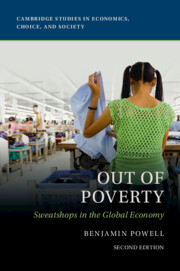Book contents
- Out of Poverty
- Cambridge Studies in Economics, Choice, and Society
- Out of Poverty
- Copyright page
- Contents
- Figures
- Tables
- Acknowledgments
- Preface
- 1 Introduction
- 2 The Anti-Sweatshop Movement
- 3 The Economics of Sweatshop Wage Determination
- 4 Don’t Cry for Me Kathie Lee
- 5 Health, Safety, and Working Conditions Laws
- 6 The Rana Plaza Disaster and Its Aftermath
- 7 Save the Children?
- 8 Is It Ethical to Buy Sweatshop Products?
- 9 A History of Sweatshops, 1780–2019
- 10 The Process of Economic Development
- 11 What Good Can Activists Do?
- 12 Conclusion
- Bibliography
- Index
7 - Save the Children?
Published online by Cambridge University Press: 02 January 2025
- Out of Poverty
- Cambridge Studies in Economics, Choice, and Society
- Out of Poverty
- Copyright page
- Contents
- Figures
- Tables
- Acknowledgments
- Preface
- 1 Introduction
- 2 The Anti-Sweatshop Movement
- 3 The Economics of Sweatshop Wage Determination
- 4 Don’t Cry for Me Kathie Lee
- 5 Health, Safety, and Working Conditions Laws
- 6 The Rana Plaza Disaster and Its Aftermath
- 7 Save the Children?
- 8 Is It Ethical to Buy Sweatshop Products?
- 9 A History of Sweatshops, 1780–2019
- 10 The Process of Economic Development
- 11 What Good Can Activists Do?
- 12 Conclusion
- Bibliography
- Index
Summary
This chapter shows that child labor is common in most countries with sweatshops but that most children don’t work in manufacturing – most work in agriculture or the service sector. Thus, calls to ban imported sweatshop goods made using child labor ends up shifting even more children into agriculture and services where pay is often lower and work less safe. The chapter argues that the process of economic development that raises average incomes has been the main cure for child labor. Anti–child labor laws typically codify improvements that market competition already achieved.
- Type
- Chapter
- Information
- Out of PovertySweatshops in the Global Economy, pp. 105 - 117Publisher: Cambridge University PressPrint publication year: 2025

